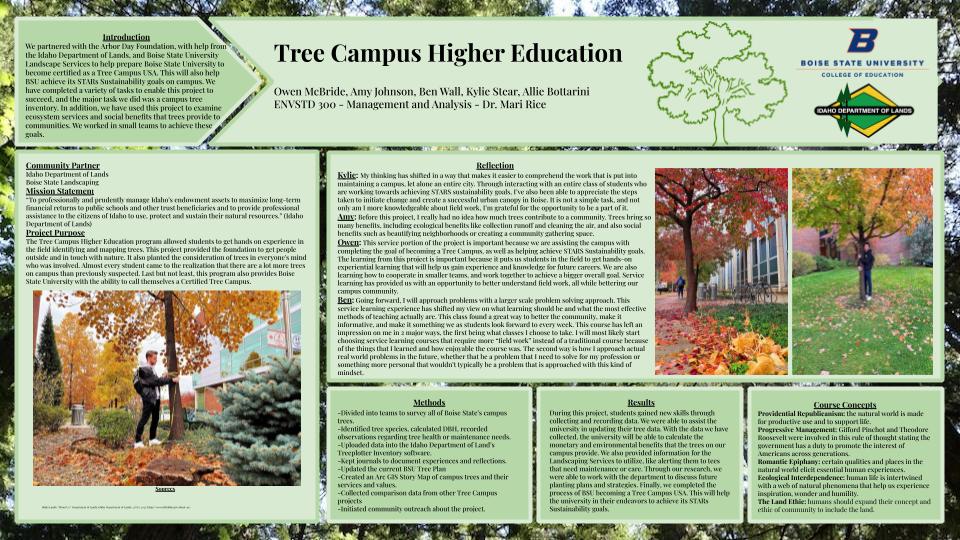Owen McBride, Amy Johnson, Ben Wall, Kylie Stear, Allie Bottarini
Dr. Mari Rice – ENVSTD 300
Arbor Day Foundation, Idaho Department of Lands

Introduction
We partnered with the Arbor Day Foundation, with help from the Idaho Department of Lands, and Boise State University Landscape Services to help prepare Boise State University to become certified as a Tree Campus USA. This will also help BSU achieve its STARs Sustainability goals on campus. We have completed a variety of tasks to enable this project to succeed, and the major task we did was a campus tree inventory. In addition, we have used this project to examine ecosystem services and social benefits that trees provide to communities. We worked in small teams to achieve these goals.
Reflection
Kylie:
My thinking has shifted in a way that makes it easier to comprehend the work that is put into maintaining a campus, let alone an entire city. Through interacting with an entire class of students who are working towards achieving STARS sustainability goals, I’ve also been able to appreciate the steps taken to initiate change and create a successful urban canopy in Boise. It is not a simple task, and not only am I more knowledgeable about field work, I’m grateful for the opportunity to be a part of it.
Amy:
Before this project, I really had no idea how much trees contribute to a community. Trees bring so many benefits, including ecological benefits like collection runoff and cleaning the air, and also social benefits such as beautifying neighborhoods or creating a community gathering space.
Owen:
This service portion of the project is important because we are assisting the campus with completing the goal of becoming a Tree Campus, as well as helping achieve STARS Sustainability goals. The learning from this project is important because it puts us students in the field to get hands-on experiential learning that will help us gain experience and knowledge for future careers. We are also learning how to cooperate in smaller teams, and work together to achieve a bigger overall goal. Service learning has provided us with an opportunity to better understand field work, all while bettering our campus community.
Ben:
Going forward, I will approach problems with a larger scale problem solving approach. This service learning experience has shifted my view on what learning should be and what the most effective methods of teaching actually are. This class found a great way to better the community, make it informative, and make it something we as students look forward to every week. This course has left an impression on me in 2 major ways, the first being what classes I choose to take. I will most likely start choosing service learning courses that require more “field work” instead of a traditional course because of the things that I learned and how enjoyable the course was. The second way is how I approach actual real world problems in the future, whether that be a problem that I need to solve for my profession or something more personal that wouldn’t typically be a problem that is approached with this kind of mindset.
Community Partner: Arbor Day Foundation, Idaho Department of Lands
Mission Statement:
“To professionally and prudently manage Idaho’s endowment assets to maximize long-term financial returns to public schools and other trust beneficiaries and to provide professional assistance to the citizens of Idaho to use, protect and sustain their natural resources.” (Idaho Department of Lands)
Project Purpose:
The Tree Campus Higher Education program allowed students to get hands on experience in the field identifying and mapping trees. This project provided the foundation to get people outside and in touch with nature. It also planted the consideration of trees in everyone’s mind who was involved. Almost every student came to the realization that there are a lot more trees on campus than previously suspected. Last but not least, this program also provides Boise State University with the ability to call themselves a Certified Tree Campus.

Course Concepts
- Providential Republicanism: the natural world is made for productive use and to support life.
- Progressive Management: Gifford Pinchot and Theodore Roosevelt were involved in this rule of thought stating the government has a duty to promote the interest of Americans across generations.
- Romantic Epiphany: certain qualities and places in the natural world elicit essential human experiences.
- Ecological Interdependence: human life is intertwined with a web of natural phenomena that help us experience inspiration, wonder and humility.
- The Land Ethic: humans should expand their concept and ethic of community to include the land.
Methods
- Divided into teams to survey all of Boise State’s campus trees.- Identified tree species, calculated DBH, recorded observations regarding tree health or maintenance needs.
- Uploaded data into the Idaho Department of Land’s Treeplotter Inventory software.
- Kept journals to document experiences and reflections
- Updated the current BSU Tree Plan- Created an Arc GIS Story Map of campus trees and their services and values.
- Collected comparison data from other Tree Campus projects
- Initiated community outreach about the project.
Results
During this project, students gained new skills through collecting and recording data. We were able to assist the university in updating their tree data. With the data we have collected, the university will be able to calculate the monetary and environmental benefits that the trees on our campus provide. We also provided information for the Landscaping Services to utilize, like alerting them to tees that need maintenance or care. Through our research, we were able to work with the department to discuss future planting plans and strategies. Finally, we completed the process of BSU becoming a Tree Campus USA. This will help the university in their endeavors to achieve its STARs Sustainability goals.